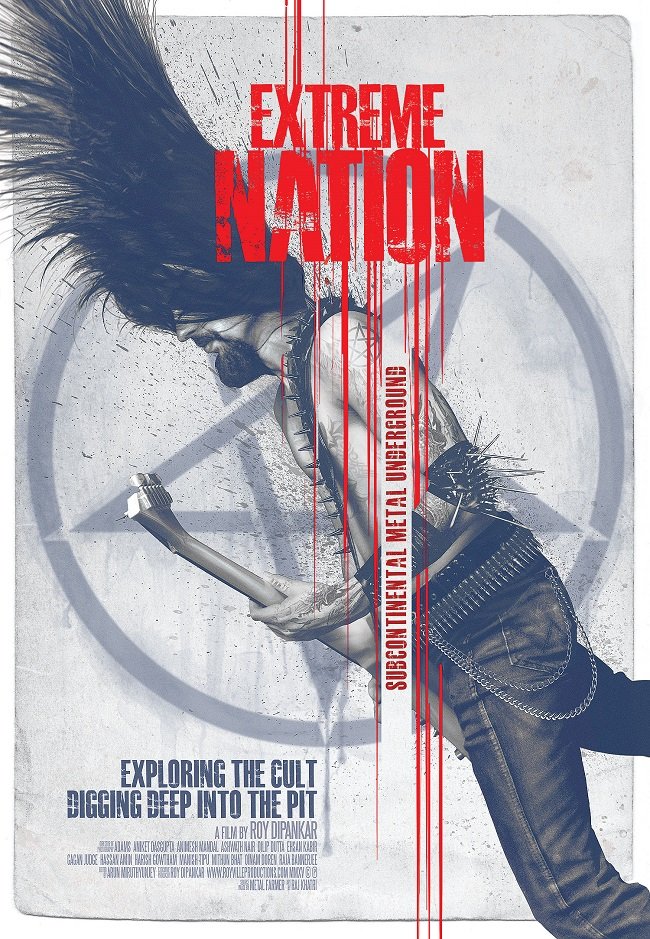Film review: Extreme Nation - extreme metal from the Indian subcontinent
Words by Ella Patenall
Extreme Nation is an award-winning documentary about the extreme metal subculture from the Indian subcontinent. Premiering in 2019, the film was released to the public via Doc’n Roll Films in 2020 as countries went into lockdown in response to the COVID-19 pandemic. It was directed and produced by filmmaker and die-hard underground music fan Roy Dipankar who captured footage between 2013-2017 as he documented the burgeoning metal scene he was witnessing.
The 81-minute documentary has a DIY feel as you’re taken around the underground metal scenes across India, Bangladesh, Sri Lanka and Pakistan. An animated map with a pentagram moving around to each location helps viewers follow the journey. A range of people involved in the extreme metal scene are interviewed – from musicians and music fans to promoters, label owners and journalists – giving viewers a detailed view of how these scenes formed and thrive.
This subculture has emerged from the need to speak out against religious radicalism, rising waves of nationalism and injustice in the region over the years. Viewers can expect discussion on war, religion, nationalism, terrorism, protest, animal rights and political instability, among more light-hearted and comical moments. The volatility was particularly poignant when Roy visited Colombo, Sri Lanka, where the interviewee’s voice is obscured to protect his identity as he talks about the ongoing conflicts and terrorist groups functioning there. Additionally, Roy doesn’t shy away from including commentary on the more toxic and harmful elements of the metal scene such as bands holding anti-Islamic, antisemitic and nationalist views.
Artists also spoke about their motivations to go into music and what music means to them. In one scene they show a musician in a metal band interacting with his family who had initially encouraged him into more traditional music – they were bewildered by his choice into metal music, though they accepted it. It was good to get this behind-the-scenes insight into how their families reacted to their interest in metal and it’s something I’d have liked to have seen more of.
We met both obscure bands and ones touring internationally. Some bands that were included were Primitiv, Plague Throat and Syphilectomy from India; Konflict and Genocide Shrines from Sri Lanka; Multinational Corporations from Pakistan; Impiety from Singapore; Orator and Nafarmaan from Bangladesh; and Cult of Fire based in Czech Republic. The locations included in the film were Mumbai, Kolkata, Chennai, Bangalore, Ladakh, Guwahati, Shillong, Nagaland, Lahore, Dhaka and Colombo.
My one criticism of this film was the lack of a clear narrative and the jumping between times and places was confusing. This chaotic-ness may have been intentional, but it made for frustrating viewing at times, as it was hard to keep a track of which country we were in and how the conversation related to the previous one.
Despite this, Extreme Nation offers a fascinating snapshot into extreme metal subculture, and it is a documentary I recommend metal fans and music lovers in general to watch. It was great to see a counterculture that creates a sense of belonging among the outcasts, a community beyond borders and away from the political uncertainty and growing unrest in wider society.
Extreme Nation is available to watch on Vimeo.
About Ella
Ella Patenall is a musician, gig-goer and writer from London. She plays guitar and sings in post-punk band Dogviolet and makes music under her solo project Kindred Fawn. She also writes music reviews for music blog Get In Her Ears and loves championing exciting emerging artists.

